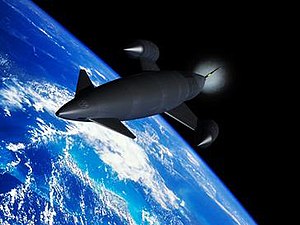
Back سكايلون (مركبة فضائية) Arabic Skylon Catalan Skylon (Raumfähre) German Skylon Esperanto Skylon Spanish Skylon Estonian اسکایلون Persian Reaction Engines Skylon Finnish Skylon French סקיילון (חללית) HE
| Skylon | |
|---|---|

| |
| Artist's concept of a Skylon reaching orbit. | |
| Role | Reusable spaceplane |
| National origin | United Kingdom |
| Designer | Reaction Engines Limited |
| Status | Under development |
| Developed from | HOTOL (Horizontal Take-Off and Landing) project |
Skylon is a series of concept designs for a reusable single-stage-to-orbit spaceplane by the British company Reaction Engines Limited (Reaction), using SABRE, a combined-cycle, air-breathing rocket propulsion system.
The vehicle design is for a hydrogen-fuelled aircraft that would take off from a specially built reinforced runway, and accelerate to Mach 5.4 at 26 kilometres (85,000 ft) altitude (compared to typical airliner's 9–13 kilometres or 30,000–40,000 feet) using the atmosphere's oxygen before switching the engines to use the internal liquid oxygen (LOX) supply to accelerate to the Mach 25 necessary to reach a 400 km orbit.[1]
It would carry 17 tonnes (37,000 lb) of cargo to an equatorial low Earth orbit (LEO); up to 11 tonnes (24,000 lb) to the International Space Station, almost 45% more than the capacity of the European Space Agency's Automated Transfer Vehicle;[2] or 7.3 tonnes (16,000 lb) to Geosynchronous Transfer Orbit (GTO),[citation needed] over 24% more than SpaceX Falcon 9 launch vehicle in reusable mode (as of 2018[update][3][4]).
The relatively light vehicle would re-enter the atmosphere and land on a runway, being protected from the conditions of re-entry by a ceramic matrix composite skin. When on the ground, it would undergo inspection and necessary maintenance, with a turnaround time of approximately two days, and be able to complete at least 200 orbital flights per vehicle.
As work on the project has progressed, information has been published on a number of design versions, including A4,[5] C1,[6] C2,[7] and D1.[8] Testing of the key technologies was successfully completed in November 2012, allowing Skylon's design to advance from its research phase to a development phase.[9][10] As of 2021[update], the groundworks for an engine test facility have been completed at Westcott[needs update]. Current plans are for the plant to be completed and the first ground-based engine tests to begin in 2021, and SABRE engines could be performing uncrewed test flights in a "hypersonic testbed" (HTB) by 2025.[11]
In paper studies, the cost per kilogram (kg) of payload carried to LEO in this way is hoped to be reduced from the current £1,108/kg (as of December 2015[update]),[12] including research and development, to around £650/kg (718.16USD/Kg), with costs expected to fall much more over time after initial expenditures have amortised.[13] In 2004, the developer estimated the total lifetime cost of the Skylon C1 programme to be about $12 billion.[13] As of 2017[update], only a small portion of the funding required to develop and build Skylon had been secured. For the first couple of decades the work was privately funded, with public funding beginning in 2009 through a European Space Agency (ESA) contract. The British government pledged £60 million to the project on 16 July 2013 to allow a prototype of the SABRE engine to be built;[14] contracts for this funding were signed in 2015.
- ^ Hempsell & Longstaff 2009, p. 5.
- ^ Clark, Stuart (17 July 2013). "Sabre rocket engine could open up access to space as never before". The Guardian. London.
- ^ ""Capabilities & Services (2016)". SpaceX.
- ^ Elon Musk [@elonmusk] (30 April 2016). "@elonmusk Max performance numbers are for expendable launches. Subtract 30% to 40% for reusable booster payload" (Tweet) – via Twitter.
- ^ Varvill & Bond 1993, p. 165, Fig 1.
- ^ Varvill & Bond 2004.
- ^ Hempsell & Longstaff 2009.
- ^ Hempsell & Longstaff 2014.
- ^ "Skylon spaceplane engine concept achieves key milestone". BBC News. 28 November 2012. Retrieved 28 November 2012.
- ^ "Hypersonic Flight 'Breakthrough' Could Have Us in Tokyo by Lunch". Wired. 30 November 2012.
- ^ "BAE invests in space engine firm Reaction Engines". BBC News. 2 November 2015.
- ^ "SpaceX published Launch costs for Falcon Heavy to LEO for 2016 launch". SpaceX. 2015. Archived from the original on 7 October 2013.
- ^ a b "Skylon FAQ". Frequently Asked Questions. Reaction Engines Ltd. 2010. Archived from the original on 2 June 2015. Retrieved 25 January 2011.
- ^ "UK earmarks £60m for super-fast space rocket engine". The Guardian. London. 16 July 2013.
© MMXXIII Rich X Search. We shall prevail. All rights reserved. Rich X Search